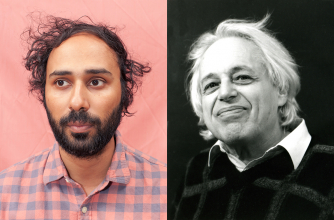Details
Royal Academy of Music
Marylebone Road
Marylebone
London
NW1 5HT
England
Programme
Qasim Naqvi – Preamble (2015)
György Ligeti – Chamber Concerto for 13 Instrumentalists (1969/70)
Performers
Elias Brown – Conductor
Ensemble Query
Programme Note
Qasim Naqvi Preamble (2015, UK Premiere)
1. Preamble
2. Meg Erase Meta
3. Children of the Drawer Pt. 1 + Imagined Garages Pt. 2
4. Behind Stars
5. Aero
Performed with permission from Erased Tapes Music.
György Ligeti Chamber Concerto for 13 Instrumentalists (1969/70)
1. Corrente (Fließend)
2. Calmo, sostenuto
3. Movimento preciso e meccanico
4. Presto
Performed with permission from Schott Music GbmH & Co. KG.
Featuring the Ondine Quartet, members of the Lyrus Winds, and featured guests.
Qasim Naqvi (1977- ) is a drummer, composer, and member of the band Dawn of Midi. He currently resides in Brooklyn, NY.
Preamble is a collection of short works for mixed instruments. It was originally commissioned by the media artist Mariam Ghani and the St. Louis Museum of Art as a score to a video installation titled The City and the City, a noir construction based on China Mievelle’s novel of the same name.
Preamble draws from traditional, graphic and variable notational forms. This system mainly applies to rhythm, dynamics and ranges that are unique to the instrumental makeup of the piece. With this type of notational abstraction, Preamble can have a unique identity from performance to performance, yielding infinitely different outcomes.
The conductor is responsible for controlling the output of the ensemble’s collective choices, by shaping dynamics, bringing certain instruments in and out of play and determining the length of repeated sections within a movement. Just as the performers use their listening and intuition to make decisions in real time, the conductor makes intuitive choices in controlling the ensemble.
György Ligeti was born in Transylvania, Romania in 1923.
The Chamber Concerto for 13 Instrumentalists (1969/70) is a conceptual tour de force, a virtuoso showing for every member of the ensemble, and both a summation of Ligeti's compositional output of the 1960s and turning point to a new focus on melody. Throughout, we hear Ligeti's signature mikropolyphonie –– the tight, tessellated repetition of melodic cells, forming a "densely woven cobweb... a microscopic, underwater world", in the composer's own words. However unlike Ligeti's earlier works, where individual lines shimmer as inscrutable surface texture, here they unwind, rise to the surface, and explode, often marked in the score as "gerissen" ('torn off'). In all movements but reaching its climax in the third movement, we hear a continuation of experiments in acoustic translations of granular synthesis, first explored in his Continuum for solo harpsichord, written the previous year. An appropriation of methods studied with Stockhausen in the 1950s at the WDR studio for electronic music in Cologne, Ligeti writes lines played so rapidly that the tones themselves dissolve, creating "a series of sound impulses in rapid succession which create the impression of continuous sound," Ligeti writes. In the Chamber Concerto, however, this granulation serves as a point of transition and release –– miniscule time-granules expand into a complex rhythmic cloud, recalling the sound of clocks and foreshadowing his 1972 Clocks and Clouds.

 Your events at Classical Events
Your events at Classical Events

